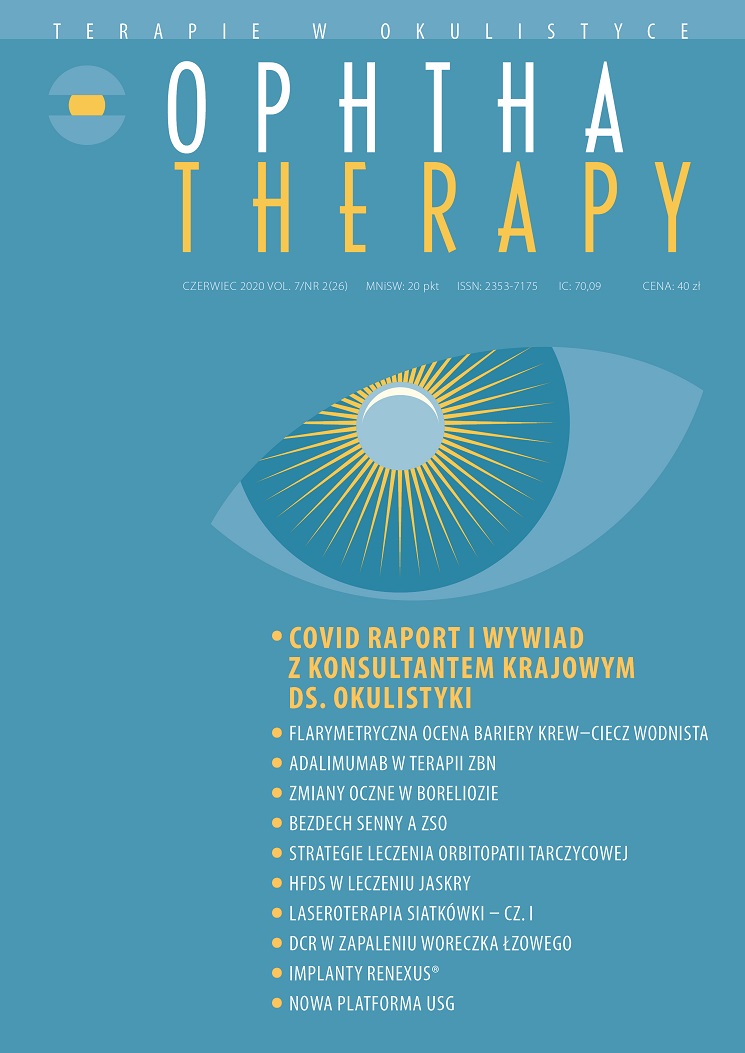Lato, koronawirus i zespół suchego oka – skuteczne metody leczenia List do Redakcji
##plugins.themes.bootstrap3.article.main##
Abstrakt
Od grudnia pandemia COVID-19 dotyka wiele osób. Dzisiaj żyjemy w innej rzeczywistości. Jednak mimo śmiertelnego zagrożenia dalej musimy nieść pomoc pacjentom z rozmaitymi problemami medycznymi. Często do gabinetu okulistycznego trafiają osoby z zespołem suchego oka. Zwykle nie jest to poważna komplikacja, jednak może dotkliwie utrudniać życie pacjentów, a w wyjątkowych sytuacjach zrujnować ich widzenie. W pracy zostaną przedstawione objawy zespołu suchego oka, jego przyczyny, a także skuteczne metody leczenia. Omówiono również problem COVID-19 jako jednostki chorobowej, objawy oczne, które może powodować, oraz częstość występowania objawów okulistycznych u osób z tą chorobą. Ponadto opisany został związek między koronawirusem a zespołem suchego oka.
Pobrania
##plugins.themes.bootstrap3.article.details##

Utwór dostępny jest na licencji Creative Commons Uznanie autorstwa – Użycie niekomercyjne – Bez utworów zależnych 4.0 Międzynarodowe.
Copyright: © Medical Education sp. z o.o. License allowing third parties to copy and redistribute the material in any medium or format and to remix, transform, and build upon the material, provided the original work is properly cited and states its license.
Address reprint requests to: Medical Education, Marcin Kuźma (marcin.kuzma@mededu.pl)
Bibliografia
2. Ambroziak AM. Ciężki zespół suchego oka – epidemiologia i klasyfikacja na podstawie aktualnych wytycznych Oddisey Algorytm. Okulistyka. 2014; 25(1).
3. Satitpitakul V, Kheirkhah A, Crnej A et al. Determinants of Ocular Pain Severity in Patients With Dry Eye Disease. Am J Ophthalmol. 2017; 179: 198-204.
4. Nichols KK, Nichols JJ, Mitchell GL. The lack of association between signs and symptoms in patients with dry eye disease. Cornea. 2004; 23(8): 762-70.
5. Bhargava R, Kumar P. Oral omega-3 fatty acid treatment for dry eye in contact lens wearers. Cornea. 2015; 34: 413-20.
6. Dry Eye Assessment and Management Study Research Group, Asbell PA, Maguire MG et al. n-3 Fatty Acid Supplementation for the Treatment of Dry Eye Disease. N Engl J Med. 2018; 378: 1681-90.
7. Fryczkowski P. Leczenie zespołu suchego oka za pomocą kwantowego rezonansu komórkowego. OphthaTherapy. 2020; 1: 66-9.
8. Jones L, Downie LE, Korb D et al. TFOS DEWS II Management and Therapy Report. Ocul Surf. 2017; 15(3): 575-628.
9. de Paiva CS, Pflugfelder SC, Ng SM et al. Topical cyclosporine a therapy for dry eye syndrome. Cochrane Database Syst Rev. 2019; 9(9): CD010051. https://doi.org/10.1002/14651858.CD010051.pub2.
10. Malta JB, Soong HK, Shtein RM et al. Treatment of ocular graft-versus-host disease with topical cyclosporine 0.05%. Cornea. 2010; 29(12): 1392-96.
11. Avunduk AM, Avunduk MC, Varnell ED et al. The comparison of efficacies of topical corticosteroids and nonsteroidal anti-inflammatory drops on dry eye patients: a clinical and immunocytochemical study. Am J Ophthalmol. 2003; 136(4): 593-602.
12. Pinto-Fraga J, López-Miguel A, González-García MJ et al. Topical Fluorometholone Protects the Ocular Surface of Dry Eye Patients from Desiccating Stress: A Randomized Controlled Clinical Trial. Ophthalmology. 2016; 123(1): 141-53.
13. Drouault-Holowacz S, Bieuvelet S, Burckel A et al. Antioxidants intake and dry eye syndrome: a crossover, placebo-controlled, randomized trial. Eur J Ophthalmol. 2009; 19(3): 337-42.
14. Shigeyasu C, Hirano S, Akune Y et al. Diquafosol Tetrasodium Increases the Concentration of Mucin-like Substances in Tears of Healthy Human Subjects. Curr Eye Res. 2015; 40(9): 878-83.
15. Ueda K, Matsumiya W, Otsuka K et al. Effectiveness and relevant factors of 2% rebamipide ophthalmic suspension treatment in dry eye. BMC Ophthalmol. 2015; 15: 58.
16. Prost ME. Koronawirus a narząd wzroku. Możliwości zakażenia, objawy kliniczne i profilaktyka w gabinecie okulistycznym. OphthaTherapy. 2020; 25(1): 5-9.
17. Chen L, Liu M, Zhang Z et al. Ocular manifestation of a hospitalized patient with confirmed 2019 novel coronavirus disease. BJ Ophthalmol. 2020; 104(6): 748-51.
18. Seah I, Agrawal R. Can the Coronavirus Disease 2019 (COVID-19) Affect the Eyes? A Review of Coronaviruses and Ocular Implications in Humans and Animals. Ocul Immunol Inflamm. 2020: 1-5. https://doi.org/10.1080/09273948.2020.1738501.
19. Hu K, Patel J, Patel BC. Ophthalmic Manifestation of Coronavirus (COVID-19). StatPearls Publishing 2020.
20. Sun X, Zhang X, Chen X et al. The infection evidence of SARS-COV-2 in ocular surface: single-center cross-sectional study. medRxiv 2020. https://doi.org/10.1101/2020.02.26.20027938.
21. Wu P, Duan F, Luo C et al. Characteristics of Ocular Findings of Patients with Coronavirus Disease 2019 (COVID-19) in Hubei Province, China. JAMA Ophthalmol. 2020; 138(5): 575-8.
22. Jacomy H, Talbot PJ. Vacuolating encephalitis in mice infected by human coronavirus OC43. Virology. 2003; 315(1): 20-33.
23. Yeh EA, Collins A, Cohen ME et al. Detection of coronavirus in the central nervous system of a child with acute disseminated encephalomyelitis. Pediatrics. 2004; 113(1): e73-e76. https://doi.org/10.1542/peds.113.1.e73.

